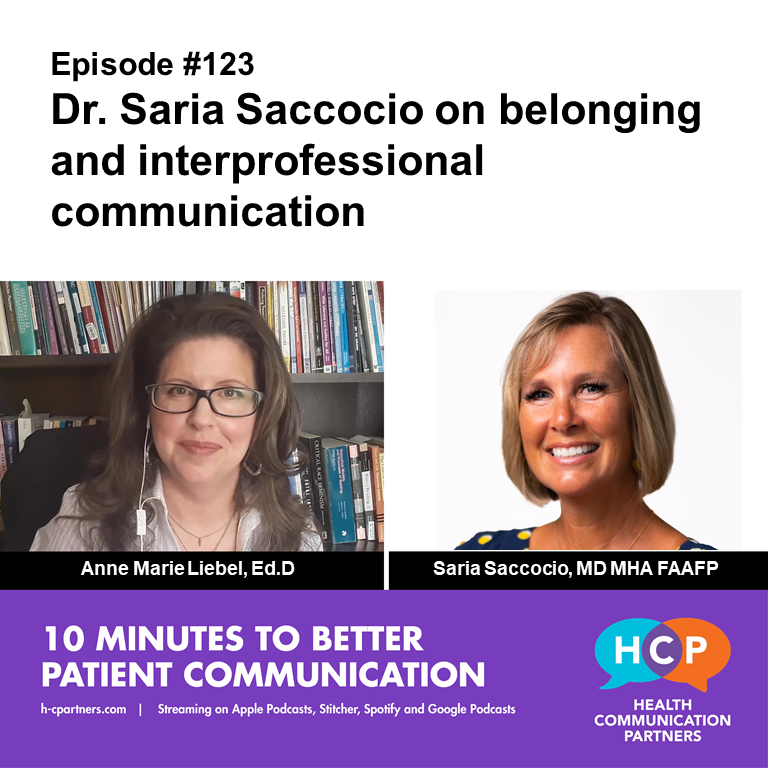Family physician and physician leader Dr. Saria Saccocio has found connections between communication and people’s sense of belonging in an organization. Belonging is one of the traits she’s noticed across the most successful teams in healthcare. Dr. Saccocio shares some practical communication strategies she uses to encourage a sense of belonging in organizations.

Clinician well-being is as important today as ever. Building equitable and welcoming working environments for all health professionals involves intentional interprofessional communication. My next guest talks about one of the traits she’s noticed across the most successful teams she’s been on, and what it has to do with communication.
Hi everybody. I’m Dr. Anne Marie Liebel, and this is “10 Minutes to Better Patient Communication” from Health Communication Partners, your partners in health-equity focused education and communication. Visit healthcommunicationpartners.com.
Today’s episode sponsored by Maven Roth Group. Maven Roth is a progressively strong, women-owned creative agency. From designing images, reports, logos, templates, and social graphics for your organization, to spreading the word thru digital, print, billboards, radio and television, Maven Roth has you covered, all the way to media buying and management. Visit mavenroth.com today.
With my guests, you may know I always let them choose what they would like to reflect on, related to communication or education. Well my next guest is family physician and physician leader Dr. Saria Saccocio. Now I’ve known Saria for years, and yet she surprised me with what she chose to talk about.
She wanted to talk about belonging. A sense of belonging and its importance in the workplace.
She takes us on a quick tour through some very practical communication strategies she uses to encourage a sense of belonging in the teams she’s in.
I was thrilled to have her on the show. We get to have a nice time during my first in person interview in years, and we even get to talk about Brenee Brown. Ok here it is.
 I’m here, live, in person, finally! With my next guest Dr. Saria Saccocio. She is a family physician and a physician executive. Dr Saccocio, welcome to the show!
I’m here, live, in person, finally! With my next guest Dr. Saria Saccocio. She is a family physician and a physician executive. Dr Saccocio, welcome to the show!
I am excited to be live with you today Anne Marie.
Thank! Well, tell us a little bit about what you do.
As a physician executive consultant, it’s my purpose to partner with clients to identify the solutions that fit their strategic plan.
That sounds like quite a lot of work!
It’s fun work.
So what is a problem that you have been facing in your work that is related to Patient communication or interprofessional communication?
Well you said it, Anne Marie. It’s one word: communication. Communication is critical to, actually, a deeper meaning and sense of what we do, and that is belonging.
Belonging? So belonging is the, is the issue that you are focused on. Okay, so how are you, how are you focusing on belonging? And how does it relate to communication?
Yes belonging is the issue Anne Marie. I’ve seen some health systems do this very well and others who struggle in getting the work done. Because it comes back to the ability to communicate and inspired by Brenee Brown’s work, in fact I’m going to use for definition here for connection and belonging: [reads] “It’s the energy that exists between people when they feel seen heard and valued.”
So in your work across different health systems and teams, this is what stands out to you? The sense of belonging, they either have it or they don’t.
Absolutely, and it’s something we work towards. But it does boil down to those three things. If you hire the right person for the job and have the right people sitting around the table, this is the key to success” being seen heard and most importantly valued.
So how do you do it? How do you, how are you addressing communication with the sense of belonging?
Well we’ll keep it simple. There are few things that I do. When I want to ensure everyone feels seen, I’m reading the room. Whether it’s a meeting in person, a virtual room, I’m recognizing who’s speaking, who’s not. Why aren’t they speaking? If they’re over speaking, how do I manage that? And there’s some skills to do that. Being heard. Now they’re a couple of ways of doing this. Sometimes that’s verbal. Some people don’t know what to do with an email. And here is my quick rule of thumb: if it’s an email that requires more than three sentences, it’s probably a conversation that deserves a phone call. Now, if you recognize one emotion, one emotion in an email, that’s an absolute direct beeline to the phone.
I love that, I love that! So thinking about the way that you respond to an email as, “Can I create a better sense of belonging just in the way that I’m responding? Do I write an email to or do I make it a phone call?” And I love that rule of thumb. What else you got?
So true! So being seen and heard is only part of the equation, as I mentioned, and most importantly is feeling valued. And one way that I do that is intentionally Express gratitude. Whether it’s a thank you note, it’s a verbal thank you, it’s “I see you and I appreciate what you’re contributing to the conversation.”
That’s quite a lot, thank you. That’s seen, heard, valued. So what are you learning by approaching communication this way with different organizations?
Well, actively working on your culture of belonging May mean that you run into a couple of potholes. So, for example, you can unfortunately and unintentionally put someone on the spot, by saying, “Anne Marie, you have had nothing to say this whole meeting! Do you have anything to say?”
Right
Probably not the best way. So words that I use are, “Anne Marie I know this is something you’re passionate about or you know a lot about. Is there something we missed?” gives them an opportunity to speak to it. But then I will also follow up afterwards to say, “Did I make it better or worse?”
Whoa! That’s a powerful statement there, “Did I make it better or worse.” That’s a, that’s a brave move!
It can take some courage to do that. But the message you send–even to the person who doesn’t feel comfortable speaking up, if perhaps they even felt that you made it worse, at least they know what your intention is, and that you are leaning into their value and what they bring to the table.
You ask their response, again trying to move toward more of a sense of belonging. So do you have something that you would like to share with people who are feeling this? Who are saying, “Okay, I want to think about my communication in terms of how can I increase the sense of belonging with my colleagues, or with my team, or within my organization!” What have you got to say?
Absolutely. And whether I was the leader at the table, or a participant in the meeting, these are the words of wisdom: be willing to change the recipe.
Ok, wait! What’s that? “Be willing to change the recipe?” Tell me!
Well, have you ever made food in the kitchen and you use your tasting spoon to make sure it’s got the right taste to it?
Yeah, yeah.
Well remember, you have many cooks at the table. Everyone has expertise they can offer. And if you’re set on a particular recipe, with certain measurements it may not be as rich or complex as a flavor, if you don’t take the advice, the input, and value every team member in the room.
I love a good metaphor! Dr. Saria Saccocio, thank you for coming by the show. Thank you for talking to us about the ways that belonging can be crafted and enhanced and experienced through communication.
Thank you Anne Marie. It’s been a delight being with you today.
I’m grateful to Dr. Saria Saccocio for being on the show. She took each of Brenee Brown’s definition for belonging “seen, heard and valued,” and gave us a communication strategy to fit that approach.
- “Seen” was the importance of reading the room, wherever you are.
- “heard” was the way we respond to email and when it merits a phone call; and
- “valued” was recognizing and inviting participation by everyone around the table.
And then she threw in some extras and they were zingers! That idea of checking back in with someone, and asking, as a result of your actions, did you make it better or worse. And I thought that was very brave. That’s a very compelling question.
And then that great cooking metaphor of not being afraid to change the recipe. That got me thinking about, in education, not being afraid to depart from the plan. Not being so tied to our own ideas about what ought to happen here that we exclude or minimize others’ contributions, and then miss out on the richness of diverse understandings and contributions.
This has been “10 Minutes to Better Patient Communication” from Health Communication Partners. Audio engineering and music by Joe Liebel. I’m Dr. Anne Marie Liebel, thanks for listening.
